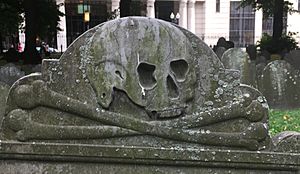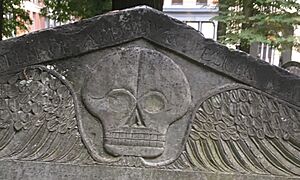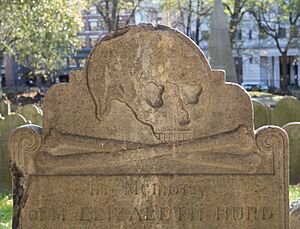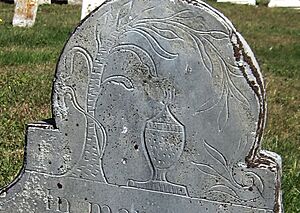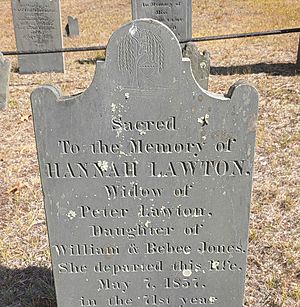Funerary art in Puritan New England facts for kids
Funerary art in Puritan New England refers to the special gravestones carved between the 1640s and the late 1700s. These stones were made by the Puritans, who were among the first European settlers in America, and their families. Early Puritan gravestones show how people in the 1600s thought about death. Death was a normal part of life for them. Their traditions and grave art give us a special look into their beliefs. The simple designs on early gravestones showed their religious rules, which avoided too much decoration.
The first Puritan graves in New England (states like Maine, Vermont, New Hampshire, Massachusetts, Connecticut, and Rhode Island) were often dug without much planning. They were placed in local burial grounds. Sometimes, they were marked with upright stones made of slate, sandstone, or granite. These stones had simple facts carved into them. Later generations added more decorations to their gravestones. The most famous design was the "death's head," which looked like a skull, sometimes with wings or crossed bones.
Even later, some stones showed the person's soul being carried to heaven by wings. After the 1690s, the images became less scary. They started to include winged cherubs (also called "soul effigies"). These cherubs had fuller faces and more lifelike eyes and mouths. In gravestones from the Federalist Era, when society became less focused on religion, you would see images of urns and willow trees.
Contents
Who Carved the Gravestones?
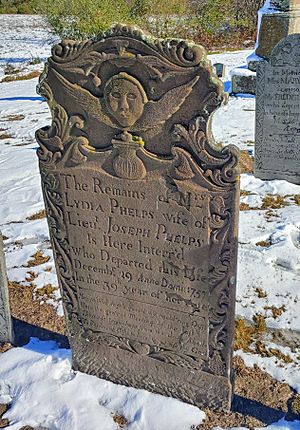
The people who first designed and carved these gravestones were often general craftsmen. They might also work as blacksmiths, leather-workers, or printers. They usually worked in their local areas. We don't know of any carvers who traveled widely to make gravestones. Many surviving gravestones share similar designs, but there are some differences between regions.
The oldest known full-time gravestone carver in the colonies was George Griswold of Windsor, Connecticut. He carved stones from the 1640s to the 1690s. His oldest surviving work is a table-like marker from 1644 for Reverend Ephraim Huit. As Boston grew, a full-time carver was needed there too. We don't know his name, but he is called "The Old Stone Cutter" or "The Charlestown Master." He carved from 1665 until the early 1700s. Two of his students, William Mumford and Joseph Lamson, became very successful carvers.
Thanks to old records and newspaper ads, we now know the names of many carvers. About 300 individual carvers in New England have been identified. However, we know very little about most of them. Some exceptions include John Lamson of Ipswich, Josiah Manning and his sons from Windham, the James Foster family from Dorchester, and John Stevens of Newport.
By the mid-1700s, stone carving became its own industry. It had its own system of training and workshops. Even though it wasn't considered "fine art," it needed a lot of skill. Carvers had to choose stones, shape them, prepare their surfaces, and carve the designs. Different styles of carving appeared in different New England regions. The John Stevens Shop in Newport became popular. It competed with new Rhode Island carvers like Gabriel Allen and Charles Hartshorn. These carvers used local slate.
The Connecticut River valley was known for its brownstone quarries. Many carvers in that area used brownstone. Portland, Connecticut had one of the largest brownstone quarries. Many carvers lived there because of the easy supply of stone. Families like the Stanclift Family and Thomas Johnson Family became famous carvers. They passed down their skills for generations. Brownstone was popular because it was softer and easier to carve detailed designs. However, it also wore away more easily than granite schist or slate.
Flat, tablet-shaped stones made of slate were popular until marble became fashionable in the early 1800s. Early Puritan carvers focused on simple lines, geometric shapes, and sometimes abstract patterns. Their work looked simple and natural. This "primitive" style is not seen in later American art.
Puritan Views on Death
Today, we often avoid thinking about death. But in Puritan society, death was a common part of life. So, their art shows a practical view. It uses realistic images that remind us of human decay, like skulls and bones. Their simple, line-drawn images were a way to reject Catholic art. This choice was also seen in their churches and paintings. However, Puritans generally avoided visual art, seeing it as worshiping idols. So, images on gravestones were some of the few artworks most people saw back then.
Puritan grave art was different from the fancy European styles of the time. The first carvers learned their craft on their own in the new world. Their work can be called "folk style." This simple style allowed more gravestones to be made without needing deep workshop experience. While New England art was influenced by English and Scottish symbols, it avoided Bible stories and images of the Christian cross.
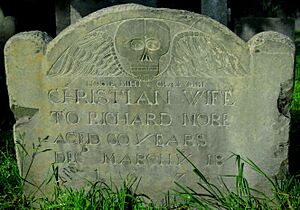
.
In the late 1800s, scholars saw old graveyards as museums. They were places to store old cultural items. But modern historians see them as valuable objects that help us understand the thoughts and beliefs of the people buried there. Historian Terry G. Jordan said that New England's many well-preserved gravestones allow us to "look so deeply into our people's past."
In 1983, historian James Hijiya pointed out that early carvers didn't leave records of their intentions. So, it's hard to know exactly what they meant. He said we need to look at other information from that time, not just the stones themselves.
Gravestones: A Changing Style
Early Puritan gravestones were usually low and wide. They often had a rounded top, like the semi-circular shapes above church doorways. This shape was symbolic. It showed the belief that death was a doorway from one world to the next. The minister William Perkins wrote that death was "a little wicket or doore whereby we passe out of this world and enter into heaven." This idea is also seen in some inscriptions. Instead of "died," they might say "translated" or "exchanged." The phrase "Here Lies the Body" meant that the body was there, but the soul had gone somewhere else.
Hijiya divides Northeastern American gravestones into six main styles. These styles show "six different attitudes toward death." The first three are strictly "Puritan." Then, the style changed as beliefs like Unitarianism and Methodism became more common. The six styles are:
- "Plain Style" (1640–1710): Shows acceptance of death.
- "Death's Head" (1670–1770): Shows awe or respect for death.
- "Cherubs" / "Angels" (1740–1820): Shows confidence in the afterlife.
- "Urn and Willow" (1780–1850): Shows mourning.
- "Monumentalism" (1840–1920): Shows defiance against death.
- "Modern Plain Style" (1900–2001): Shows ignorance or avoidance of death.
Plain Style Gravestones
The first settlers didn't use shared burial grounds right away. They often buried their dead on the highest point of their own land. Graves were marked with wooden slabs or simple field stones. The earliest Puritan burial grounds in New England date from the 1630s. They were simply places to put the dead. The early settlers tried to avoid worshiping ancestors through stone images. This was because of the second biblical commandment, "Thou shalt not make unto thee any graven image." They also avoided the traditional Catholic cross. Fancy table-like tombs were seen as too elaborate.
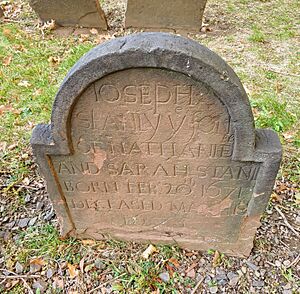
The graves had little order. They were often unmarked, or marked by a wooden sign or an uncut rock. Very few had a simple carved headstone with no decorations. When inscriptions were used, they were short and factual. They often had a raised dot between each word. They usually gave the full name, family relation, age at death, and year of death. The stone was usually put up within a year of the burial.
By the mid-1600s, gravestones became more detailed. They showed dark and bleak images of death. Soon after, many stones included epitaphs (short texts). The tone of these epitaphs often matched the seriousness of the design.
The Plain Style has smaller, undecorated gravestones with simple, factual inscriptions. It started very early in the Colonial period and lasted until about the early 1700s. Some experts think the simple carvings were due to a lack of tools or skilled stonemasons. This explains why the style lasted longer in some areas. Another reason might be that early Puritans valued humility. They deliberately kept their gravestones simple and plain. Hijiya suggests that the lack of decoration might mean they saw death as just an "ordinary" part of life, not something to be feared or celebrated.
Death's Head Designs
The "death's head" is the oldest and most common design on colonial American gravestones. The head usually has wings and is often shown with hourglasses, bones, and coffins. While it might seem scary today, the skull image was not meant to cause dread. It was a way to acknowledge that death was a normal part of human life. Puritans believed that death was when the body passed away to make way for new life in the afterlife. The skulls reflected Puritan funeral customs, including their elegies (funeral poems), funeral rites, and sermons. Often, the horses carrying the dead to the graveyard wore cloths with painted coffins and death's heads. Burials usually happened three to eight days after death, and the gravestone was put up several months later.
Funerals were expensive in the early colonies. A fancy funeral in Boston in the 1720s could cost around £100. Gravestones were a smaller part of the cost, ranging from £2 to over £40 in the 1720s.
By the mid-1700s, the death's head image sometimes became less harsh. The skull was often crowned, the lower jaw was removed, and teeth appeared on the upper row. The eyes became more lively, sometimes almond-shaped with pupils, making it look more like a soul than a skull. Death's head designs became less common by the 1780s and mostly disappeared around 1805.
Other images like leaves, grapes, vines, and hearts suggested new life through religious ceremonies and resurrection. This change was very slow and subtle. Some stones show a mix between an empty skull and a lively soul. Other designs from this time included "imps of death." These were small, evil-looking figures carrying arrows of death. They are especially linked to the Charlestown carver Joseph Lamson. He carved imps either carrying the coffin or with images of death like scythes and hourglasses.
Cherub Designs
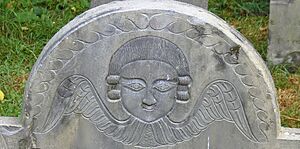
Cherubs (or "soul effigies") were the next step in the evolution of winged death heads. They were skull-shaped figures with clear human faces. They were meant to represent the soul of the person who died. Some were placed inside a sun symbol or a tree. Others kept the angel wings seen in the death's head designs.
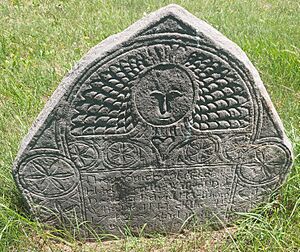
Cherubs became common in the Boston area in the mid-1700s. They were more often found in southern New England, like Rhode Island and Connecticut. In these areas, most gravestone designs from the early 1700s were already cherubs or winged souls. Some cherubs had unique faces and might have been like portraits. In Eastern Massachusetts, cherubs on male graves often had hair curling downwards, while those on female graves had hair curling upwards.
Cherubs in the Boston Region were mostly carved from the mid-1700s until about 1810. They were directly related to earlier funeral art, often showing a living human with wings. The John Stevens Shop in Newport started using cherub designs as early as 1705. Carvers in the Merrimack Valley region used soul/cherub designs starting in the 1680s. John Hartshorne of Rowley, Massachusetts began carving graves around 1680. He moved to Franklin, Connecticut around 1710 and continued carving until 1737, bringing the cherub design to that area. Soon, carvers like Obadiah Wheeler of Lebanon and Benjamin Collins of Columbia started using soul effigies and other designs inspired by Hartshorne's work. This shows how regional designs spread among carvers during the colonial era.
Urn and Willow Designs
During the Federalist Era, from about 1790 to 1820, society became less religious. This led to the popularity of urn and willow images on gravestones. During this time, the designs moved away from English influences. Instead, they favored Neoclassicism and Greek Revival styles. This marked the decline of Puritan influence. In the first two decades of the 1800s, fancy borders on gravestones were quickly replaced by simple lines and abstract designs. Often, borders that looked like pillars were used, showing the neoclassical influence. Along with urns and willows, some designs featured sunsets, especially by Rhode Island stonecutters.
Monumentalism and Modern Plain Style
By the early 1800s, social classes became more important. Graveyards lost their earlier equal look. Before this, all gravestones were similar in size, and plots were grouped together. Plots in certain areas of graveyards became more expensive. There was a clear difference between cemeteries in wealthy areas and less wealthy areas. Wealthy graveyards became grand and monumental, with large, impressive stones. Poorer graveyards had crowded rows of simple gravestones.
This change was especially clear from the 1840s. A trend emerged to combine nature and landscape in cemeteries. This led to the use of obelisks, columns, and statues. Slate, brownstone, and schist were mostly replaced by marble. Also, because of disease and smell concerns in growing cities, graveyards were moved to the edges of towns. They were no longer a central part of the landscape. This is when the Puritan traditions in funerary art ended.
Historian Karen Wenhworth Batignani describes New England gravestones from 1900 as "far less interesting than their predecessors." She says they are polished granite blocks that only show names and dates, giving few clues about the person. She and other historians believe this shows a culture that avoids thinking about death.
Gravestones: What They Say
Epitaphs
Epitaphs became common from the late 1600s. From these, we can learn about the attitudes of both the carvers and the people who died. They often included memento moris, which are reminders of death:
Remember me as you pass by
As you are now so once was I
As I am now you soon must be
Prepare for death and follow me
These early examples show the pessimistic Puritan view of the time. They don't mention an afterlife or resurrection. The text often includes images of worms, decay, and dust. It's only on the much later cherub stones that more personal goodbyes to loved ones, or mentions of an afterlife, start to appear:
Farewell my wife and children dear
I leave you for a while
For God has called and I must go
And leave you all behind.
Studying Gravestone Art
Seriously studying early Puritan funerary art is a fairly new field. The historian and photographer Harriette Forbes, working with historian Ernest Caulfield in Massachusetts in the 1920s, was the first to study this topic. She collected the first large library of photographs and a detailed list of 16th-century graves. Her book Gravestones of Early New England and the Men Who Made Them, 1653-1800 classified and explained these objects. The famous Puritan minister Cotton Mather noted in 1693 how "the stones in this wilderness are already grown so witty as to speak."
Modern scholars have a more careful view. Most early carvers were often amateurs. They had basic ideas about symbols, but their style developed without much influence from European trends. Historian Richard Meyer agrees with Mather's idea. He notes that studying these old graveyards helps us understand how these objects "establish patterns of communication" with those who see them.
The next important book was Allen Ludwig's 1966 book Graven Images: New England Stone Carving and its Symbols, 1650-1815. This book mostly described specific examples rather than giving broad overviews.
Because so many examples still exist, art historian James Blachowicz created a catalog in 2006. It listed 8,000 stones and 713 burial grounds. He listed about 1,300 stones that were signed or documented. He greatly improved the methods used to figure out which carver made which gravestone. He identified 60 sets of typefaces, showing how styles of letters, numbers, and symbols could help group gravestones by their carvers.


